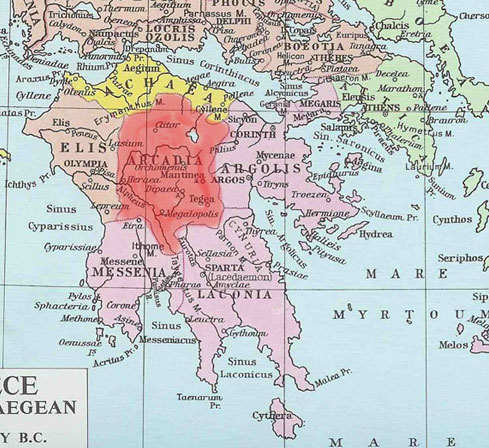In Greece, on the central plateau of the Peloponnesus, the ancient district of Arcadia was isolated from the coast, surrounded on all sides by high mountains. The plateau is also subdivided by smaller ranges. The Arcadians lived simple lives, untouched by the progress that marked the rest of Greece. The name Arcadia thus came to be a symbol of ideal simplicity, rural beauty, and contentment. It was represented as a kind of paradise in Greek and Roman poetry and Renaissance romances. (Encyclopędia Britannica Online.)
* * *A country in the middle of the Peloponnesus, surrounded on all sides by mountains, the Switzerland of Greece. The Acheloüs, the greatest river of the Peloponnesus, rises in Arcadia. The northern and eastern parts of the country were barren and unproductive; the western and southern were more fertile, with numerous valleys where corn was grown. The Arcadians regarded themselves as the most ancient people in Greece: the Greek writers call them indigenous and Pelasgians. They were chiefly employed in hunting and in the tending of cattle, whence their worship of Pan, who was especially the god of Arcadia, and of Artemis. They were passionately fond of music, and cultivated it with success. The Arcadians experienced fewer changes than any other people in Greece, and retained possession of their country upon the conquest of the rest of the Peloponnesus by the Dorians. After the Second Messenian War the different towns became independent republics, of which the most important were Mantinea, Tegea, Orchomenus, Psophis, and Pheneus. Like the Swiss, the Arcadians frequently served as mercenaries. The Lacedaemonians made many attempts to obtain possession of parts of Arcadia, but these attempts were finally frustrated by the battle of Leuctra (B.C. 371); and in order to resist all future aggressions on the part of Sparta, the Arcadians, upon the advice of Epaminondas, built the city of Megalopolis. They subsequently joined the Achaean League, and finally became subject to the Romans. (Harpers Dictionary of Classical Antiquities, 1898)
